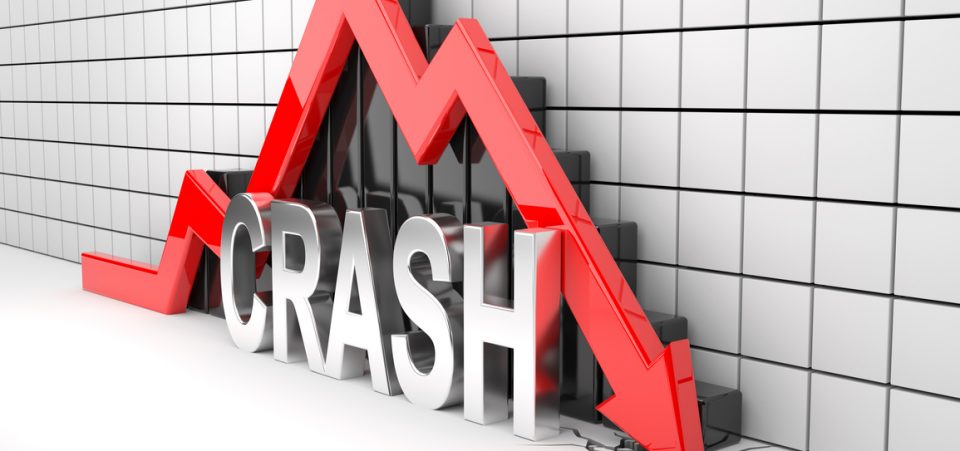We’re Stumbling Into Another Stock Market Crash

iStock.com/Onypix
Inflation Confuses Analysts and Raises Stock Market Crash Fears
U.S. inflation is confusing analysts. Some data suggests that consumer spending is dropping. In other words, consumers are not confident. They’re either delaying or avoiding big-ticket purchases such as cars and large appliances or electronics as retail sales have dropped for three months in a row. The data suggests that the Dow Jones will retract. It’s a signal of an impending stock market crash. (Source: “U.S. retail sales falter; inflation creeping higher,” Reuters, March 14, 2018.)
Those who thought the inflation data might calm investors’ fears will be disappointed. The inflation data is lower. Yes, the Federal Reserve could consider delaying its plans to raise interest rates. It may even go as far as limiting itself to three hikes instead of the expected four, as the new Chair Jerome Powell hinted in February. (Source: “Powell’s Rosy Outlook Invites Fed to Weigh Four 2018 Rate Hikes,” Bloomberg, February 28, 2018.)
Therein is the problem. Inflation is rising, and rate hikes are seen as a cause and effect mechanism that stems from favorable economic factors. But it seems this mechanism is flawed. As Powell presented it, it has optimistic implications. Yet, as reality shows, the implications are slanted more toward the pessimistic.
Analysts and economists will have to catch up to consumers. Sentiment is softening and volatility persists; how long can it be before a major stock market crash? If the markets feared the Fed’s rate hikes in February, analysts explained they feared the higher borrowing costs and, therefore, the higher costs of investing on margin.
The Federal Reserve’s Inflation Predictions Are Unrealistic
The lower inflation now shows that the Fed, and many others with it, was too optimistic. On March 20, at the next Fed meeting, Powell is expected to raise rates to 1.75%. The lower consumer confidence and the overemphasis on inflation suggest that there’s a distortion that will not benefit equities.
Powell now faces a Shakespearean dilemma: to raise or not to raise? The U.S. dollar will suffer. Indeed, the EURUSD exchange is at levels not seen since 2014—when nobody was discussing raising interest rates. There is a situation of confusion. It was inevitable, given President Trump’s “executive” style, that the markets would eventually catch up. It seems the wild bull that started after he won in November 2016 has seen its best days.
Panic Selling
The risk of panic-selling remains. Economic statistics are almost as unclear as the president’s intentions—no doubt a strategy that’s worked for him in business. That’s why the risk of panic selling is high and why a stock market crash is always within reach. In early February, the flash-crash that resized investors’ ambitions was explained as a response to inflation.
The media was bustling with reports of how great the latest job numbers were and how these would drive inflation higher. But few bothered to consider the kinds of jobs that accounted for these “great numbers.” The growth came from low-paying jobs—not the kind that is going to drive up inflation. (Source: “U.S. Starts Year With Job Surge, but Pay Gains Are Weak,” The New York Times, February 3, 2017.)
Yet, Powell will likely go ahead with raising rates at the end of March. He could deal a major blow to the retail sector, which is also bracing for the effects of the trade war with China that Trump has started. The markets will not absorb the $60.0 billion in tariffs against China without delivering a bearish message. However much the stock market benefited from Trump’s tax cuts in December, they could suffer from an extended depression in the next few months.
Nobody Knows Why Markets Are Down
Yet, while analysts and investors try to make sense of the markets, nobody has yet identified the real cause of falling stocks on Wall Street. There is simply too much disorientation. That’s why stocks have not stabilized. Perhaps because it’s difficult to gauge market sentiment, investors have not yet taken a clear course. That’s why stocks—with a few special exceptions—are fluctuating between bearish and bullish.
Wall Street drives the world market and the pattern of confusion is contagious, spreading to the European and Asian markets as well. The big risk now is that investors are wondering—if not outright panicking—if they should sell. The impression they have is that the market’s gains in 2017 have all been one giant bubble that investors have inflated since the day Trump was elected.
But, rather than assuaging fears, Trump is doubling down. The stock market is worried about what is happening in the White House. Trump has lost two big chess pieces: Chief Economic Adviser Gary Cohn and Secretary of State Rex Tillerson within the span of a week. Both probably objected to Trump’s tariff strategy and other sensitive issues, such as relations with North Korea, Russia, and China, of course. In such an environment, investors are nervous.
They are, therefore, unable to predict the course of the economy from one day—or one hour—to the next. The inflation and interest rate concerns merely add to the dilemma. Disappointing retail sales suggest that the Fed may not apply four rate hikes this year. Rather than take this as a bullish signal, investors will eventually reach the only possible interpretation: the U.S. economy is not performing as well as we think and stock prices are too high.
Disclaimer: There is no magic formula to getting rich. Success in investment vehicles with the best prospects for price appreciation can only be achieved through proper and rigorous research and ...
more


